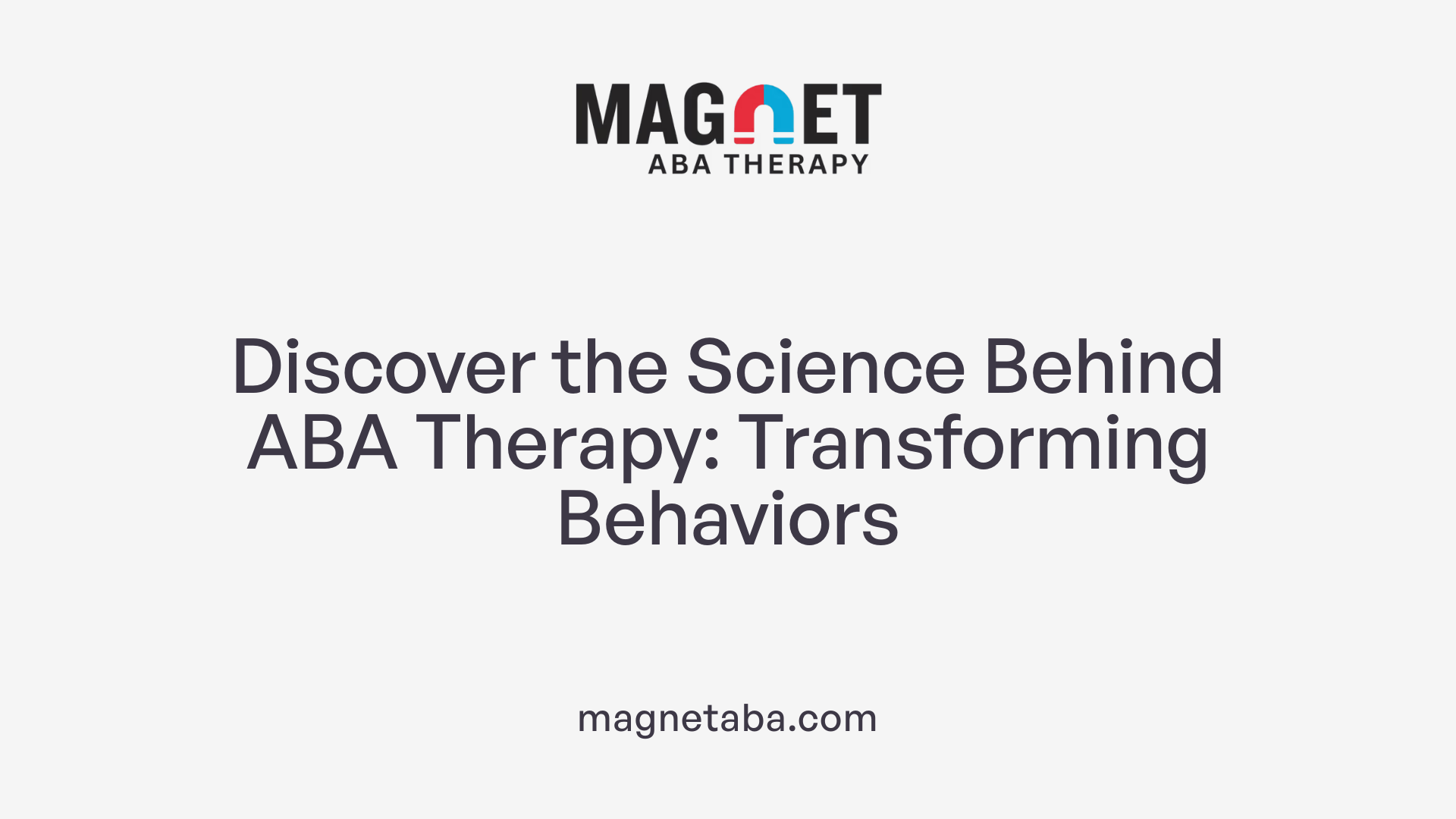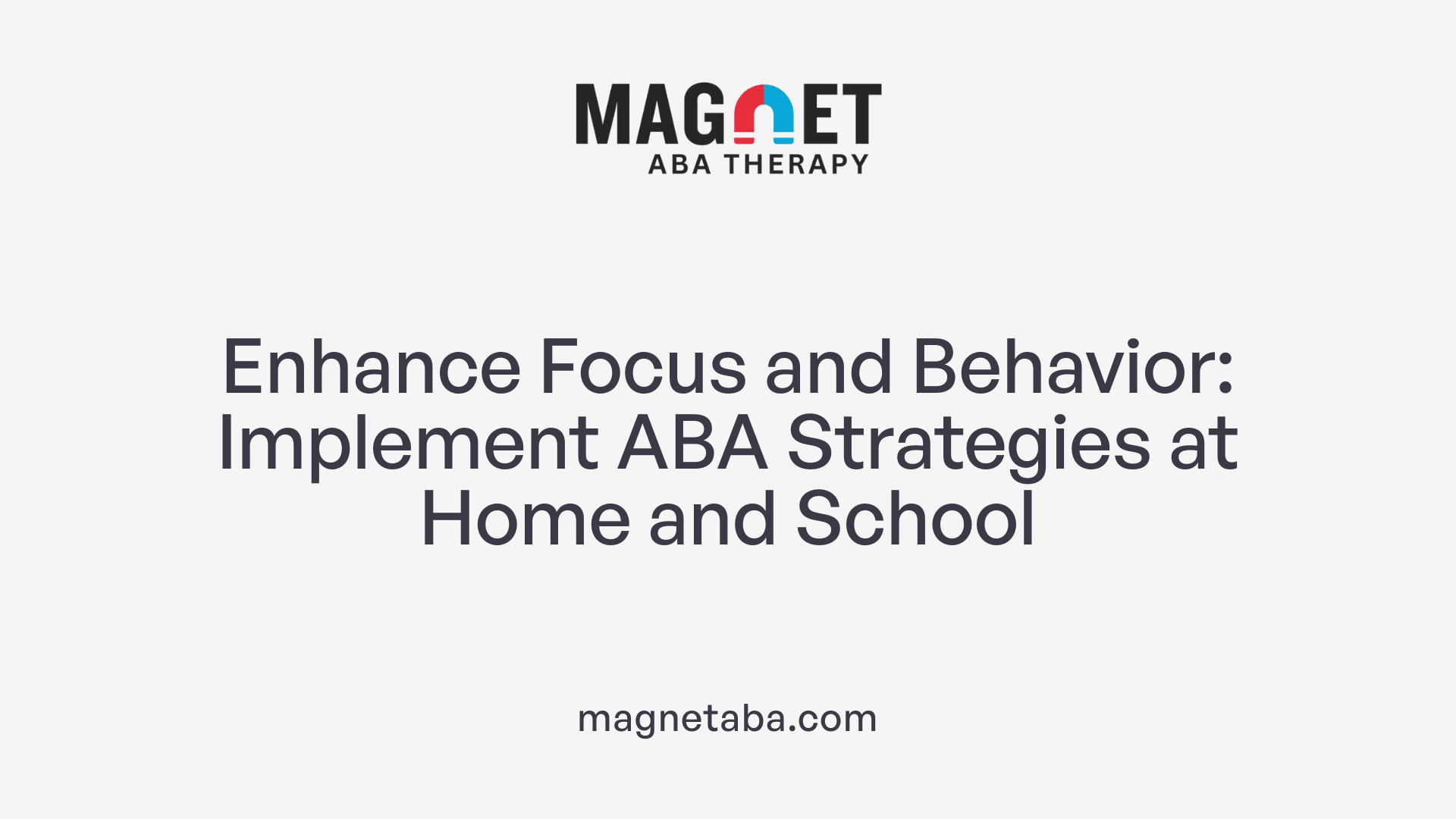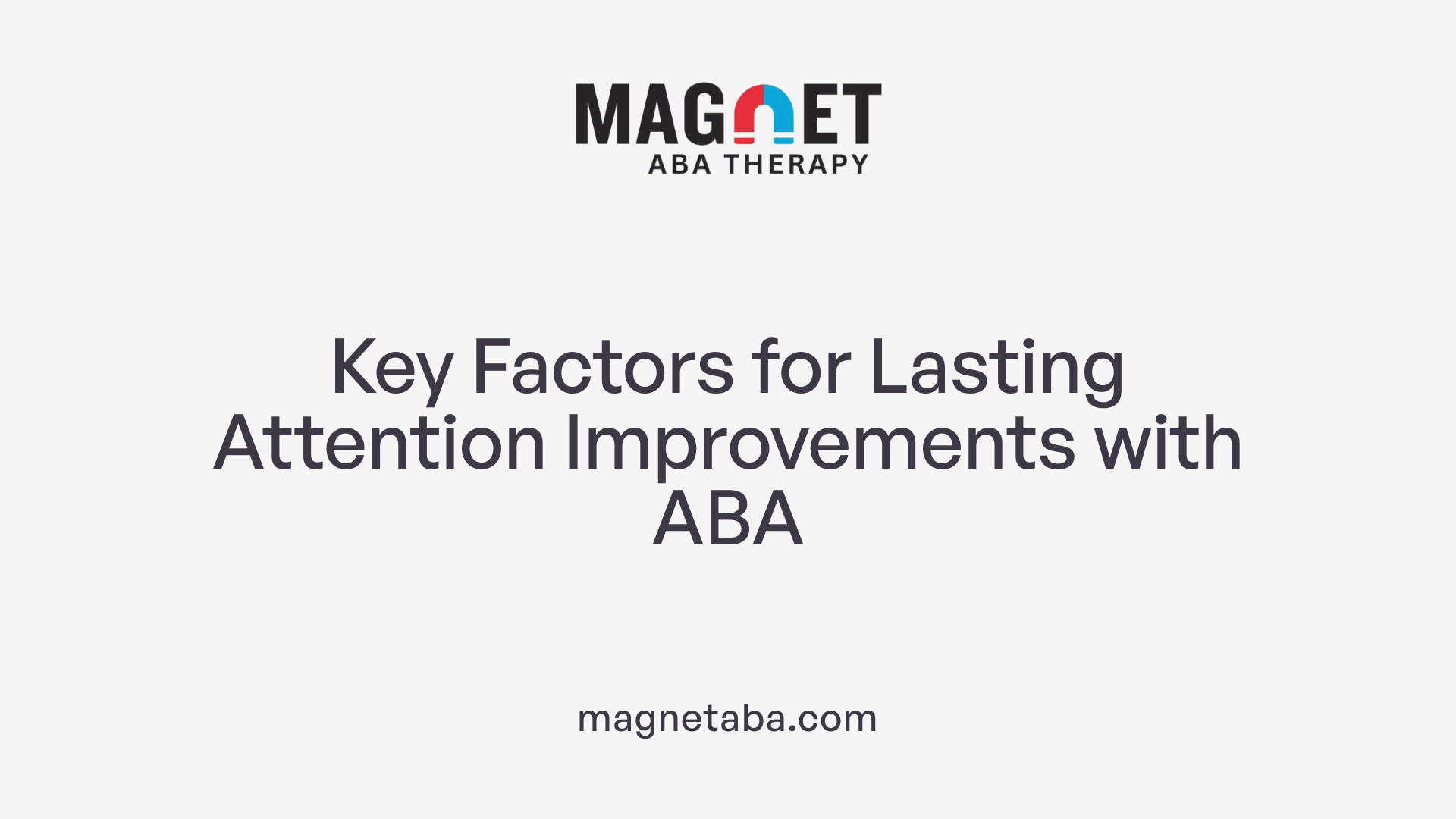Understanding ABA Therapy and Its Expanding Role
Applied Behavior Analysis (ABA) therapy, a well-established approach originally developed for supporting individuals with autism, is increasingly utilized to assist children with Attention Deficit Hyperactivity Disorder (ADHD). ABA’s structured, evidence-based methods offer promising strategies to improve attention span, self-regulation, and social skills in children facing neurodevelopmental challenges. This article explores the principles of ABA, its key techniques, and how it fosters sustainable behavioral improvements in children with autism and ADHD alike.
What is Applied Behavior Analysis (ABA) Therapy?

Definition of ABA therapy
Applied Behavior Analysis (ABA) therapy is a science-based approach that focuses on modifying behaviors through learning principles. It aims to help individuals with autism by encouraging positive behaviors and reducing challenging ones. Personalized intervention plans are designed to suit each child's unique needs, promoting improvements in communication, social skills, and daily living.
ABA’s origins and principles
Developed from B.F. Skinner's operant conditioning theory in the 1950s, ABA was adapted by Dr. Ivar Lovaas in the 1960s specifically for autism treatment. It uses structured methods like breaking tasks into smaller steps and providing positive reinforcement to motivate learning. Core principles include consistent reinforcement, task analysis, and clear goals.
Techniques used in ABA therapy
ABA utilizes several key techniques such as Discrete Trial Training (DTT), which involves step-by-step teaching with prompts and rewards, and Naturalistic Teaching, which integrates learning into everyday routines. Other methods include Pivotal Response Training for improving motivation and social behaviors, Functional Behavior Assessment to identify triggers for challenging behaviors, and token economies to reward desired actions.
ABA’s goals for individuals with autism
The primary goals of ABA therapy are to enhance meaningful behaviors like language, social interaction, and self-care skills while reducing difficult behaviors such as tantrums or aggression. Therapy is typically delivered in various settings including home, school, and daycare, guided by licensed professionals. Family involvement and ongoing progress tracking help ensure lasting improvements in the child's functioning and quality of life.
ABA therapy has strong research backing, showing significant benefits for children with autism when applied consistently and intensively. It remains a leading approach to promote independence and better integration in social and educational environments.
Key Techniques of ABA Supporting Attention and Behavior

What is Task Analysis and How Does It Help?
Task analysis breaks down complex tasks into smaller, manageable steps. For children with ADHD, this prevents feelings of overwhelm and makes it easier to complete tasks successfully. By following each step closely, children can focus better and build confidence.
How Does Positive Reinforcement Work?
Positive reinforcement involves rewarding desired behaviors immediately. Children with ADHD respond well to immediate rewards, which encourages them to repeat good behaviors. This approach promotes focus, attention, and reduces impulsivity without punishment.
What is Self-Monitoring and Its Benefits?
Self-monitoring teaches children awareness of behaviors like fidgeting or losing focus. By recognizing these actions themselves, children can work to regulate their behaviors independently, enhancing their self-control and attention over time.
How Do Modeling and Role-Playing Help?
Modeling and role-playing allow children to practice social skills and appropriate behaviors such as waiting their turn or following instructions. These methods provide safe opportunities to learn and rehearse social interactions, improving peer relationships.
What Are Discrete Trial Training, Pivotal Response Training, and Functional Behavior Assessment?
- Discrete Trial Training (DTT): Breaks skills into small parts with clear instructions and reinforcement, helping children learn through repetition.
- Pivotal Response Training (PRT): Focuses on improving motivation and social initiations, which encourages broader skill development.
- Functional Behavior Assessment (FBA): Identifies triggers and outcomes of behaviors to guide strategies that replace challenging behaviors with positive responses.
How Are These Techniques Adapted for ADHD?
ABA techniques are flexible and customized to each child’s needs, emphasizing positive reinforcement over punishment. Structured sessions and consistent feedback help children with ADHD improve focus, regulate their behavior, and enhance social skills effectively.
How ABA Enhances Attention and Self-Regulation in Children with ADHD
How ABA Is Adapted for Children with ADHD
Applied Behavior Analysis (ABA) therapy, though originally developed for autism spectrum disorders, has been effectively adapted to support children with ADHD. It focuses on individualized treatment plans that cater to unique behavioral patterns associated with ADHD, emphasizing positive reinforcement rather than punishment. This approach promotes sustainable behavioral improvements by breaking down challenging behaviors into manageable steps and encouraging self-awareness.
Reducing Impulsivity and Hyperactivity
ABA techniques target impulsivity and hyperactivity—common ADHD symptoms—through structured strategies like task analysis and behavior chaining. Task analysis involves breaking complex tasks into smaller, achievable steps, reducing overwhelm and enhancing task completion. Additionally, self-monitoring teaches children to recognize behaviors such as fidgeting or interrupting, which fosters independent regulation skills.
Improving Focus and Emotional Regulation
Improved focus and emotional regulation arise from consistent ABA interventions. Positive reinforcement motivates children by rewarding desired behaviors with immediate incentives, which is especially effective due to the inherent attentiveness of children with ADHD to immediate rewards. Furthermore, modeling and role-playing activities help practice patience and turn-taking, skills that improve social interactions and emotional control.
Use of Positive Reinforcement and Token Economies
Positive reinforcement remains a cornerstone in managing ADHD symptoms within ABA therapy. Through token economies—systems where children earn tokens exchangeable for preferred items or activities—ABA provides tangible motivation for maintaining focus and complying with behavioral expectations. These tools create a clear structure for recognizing and rewarding progress.
Integration of ABA in Everyday Settings
ABA strategies extend beyond clinical environments and are integrated into everyday settings such as homes and classrooms. Visual schedules, clear rules, and timers help create predictable routines, while social role-playing enhances communication skills. Caregiver involvement and consistency are vital for generalizing learned behaviors across multiple environments, ensuring long-term success.
Overall, ABA's blend of behavioral techniques, reinforcement methods, and individualized goals supports children with ADHD in improving attention, reducing hyperactivity, and enhancing emotional self-regulation.
The Role of ABA Providers and the Treatment Process
Who typically provides ABA therapy services?
ABA therapy services are delivered by licensed professionals, including Board Certified Behavior Analysts (BCBAs), licensed therapists, and trained behavior technicians. These specialists hold certifications and credentials ensuring they use evidence-based techniques tailored to each individual's needs.
What assessments are involved in treatment planning?
Treatment begins with a comprehensive assessment called a Functional Behavioral Assessment (FBA), which identifies the child's strengths, needs, and specific behavioral triggers. Based on this assessment, clinicians develop individualized treatment plans that set clear goals and strategies to promote positive behavioral change.
Who makes up the treatment team?
ABA therapy is often provided by a multi-disciplinary team comprised of BCBAs, Board Certified Assistant Behavior Analysts (BCaBAs), therapists, and assistant staff. This team collaborates to implement and monitor progress, adapting approaches as needed to support the child’s success.
In which settings are ABA sessions conducted?
ABA sessions occur across different environments to support skill generalization, including the child’s home, school, and daycare. This flexible structure helps integrate learning into daily routines and encourages consistent behavior improvements across settings.
ABA providers ensure high-quality care through ongoing data collection, caregiver involvement, and regular feedback. This comprehensive approach facilitates meaningful, sustainable improvements for children with autism, ADHD, and related disorders.
Verifiable Benefits of ABA Therapy for Attention and Social Skills

How Does ABA Therapy Improve Communication and Social Interaction?
ABA therapy is well-known for enhancing communication skills and social interaction, especially in children on the autism spectrum. By using methods such as modeling, role-playing, and positive reinforcement, therapy sessions teach new social behaviors like taking turns in conversations and initiating interactions. Structured techniques also help children develop better understanding of social cues and appropriate responses. These improvements foster more meaningful and effective communication with peers and adults.
What Role Does ABA Play in Enhancing Self-Regulation and Reducing Anxiety?
A crucial benefit of ABA is its support in improving self-regulation skills among individuals with neurodevelopmental disorders, including those with ADHD. Techniques like self-monitoring increase awareness of behaviors, enabling children to manage actions such as fidgeting or losing focus independently. Additionally, ABA’s consistent use of positive reinforcement contributes to reducing feelings of anxiety and overwhelm by rewarding calm, focused behaviors and creating an environment of predictability.
How Does ABA Facilitate Development of Adaptive Behaviors?
ABA’s structured interventions include breaking down complex tasks into manageable steps through task analysis. This approach helps individuals gain independence in daily living skills, such as self-care routines, organization, and completing school tasks. Adaptive behaviors also extend to social skills and emotional regulation, allowing children to better navigate social settings and manage their emotions constructively.
How Does Structure and Consistency in ABA Support Sustainable Behavioral Improvements?
One of ABA’s strengths is its emphasis on clear goal-setting, progress tracking, and regular feedback. This creates a consistent therapeutic environment where children understand expectations and receive immediate rewards for desired behaviors. The consistency across home, school, and therapy settings promotes the generalization and maintenance of new skills over time. Parental involvement further reinforces these outcomes, ensuring improvements are sustained beyond therapy sessions.
ABA therapy, validated by extensive research, offers robust benefits that go far beyond autism spectrum disorder. For children with ADHD and similar conditions, ABA’s focus on positive reinforcement, individualized plans, and supportive structure helps improve attention span, social skills, self-regulation, and quality of life.
Implementing ABA Strategies in Home and Classroom Settings to Support Attention

Use of Visual Schedules and Timers
Visual schedules help children with ADHD understand and anticipate daily activities, reducing anxiety and confusion. Timers provide clear cues for when tasks start and end, promoting on-task behavior and time awareness.
Immediate Positive Reinforcement
Providing rewards immediately after a desired behavior strengthens that behavior. For children with ADHD, who respond well to quick feedback, this technique encourages focus and compliance.
Task Breakdown and Prompting
Breaking complex tasks into small, manageable steps (task analysis) prevents overwhelm and aids completion. Prompting helps guide children through each step, with prompts gradually faded as independence grows.
Social Role-Playing to Practice Appropriate Behaviors
Role-playing scenarios like waiting turns in conversations or handling frustration offers a safe space to build social skills. This method fosters better interpersonal interactions in real life.
Creating Structured Environments for Learning
Classrooms and homes benefit from clear routines, defined rules, and predictable settings enhanced by ABA strategies. Such environments support consistent behavior and skill acquisition.
Implementing these ABA strategies provides children with ADHD the structure and support they need to improve attention, self-regulation, and social abilities both at home and in school.
Critical Success Factors in ABA Therapy for Sustained Attention Improvements

Importance of consistency and caregiver involvement
Consistency is foundational to ABA therapy's success, particularly in improving attention spans in children with ADHD. Regular, predictable application of techniques such as positive reinforcement and task analysis helps children understand expectations and internalize appropriate behaviors. Caregivers play a crucial role by maintaining this consistency across various environments, reinforcing skills independently of structured sessions.
Regular data collection and progress monitoring
Systematic data collection allows behavior analysts and caregivers to track improvements and identify areas needing adjustment. By closely monitoring behavior frequency, duration, and intensity, treatment plans can be fine-tuned to effectively support sustained attention. This evidence-based approach ensures that interventions remain aligned with each child’s evolving needs.
Generalization of skills across settings
A critical factor is ensuring that gains in attention and behavior are not limited to therapy sessions but translate into everyday settings such as home, school, and social environments. Strategies like role-playing and modeling support this transfer by providing practical practice opportunities. Collaboration between therapists and caregivers facilitates consistent reinforcement across contexts, promoting meaningful behavioral changes.
Role of parental training and collaboration with professionals
Parental involvement extends beyond observation; training empowers parents with techniques to support their child's development proactively. Close collaboration between parents and licensed behavioral professionals ensures that interventions are practical, individualized, and responsive. This partnership enhances therapy outcomes by creating a unified support system for the child’s attention improvement journey.
Harnessing ABA to Foster Lasting Attention and Behavioral Gains
ABA therapy provides a flexible, individualized, and evidence-based pathway to support children with autism and ADHD in developing stronger attention spans, better self-regulation, and enhanced social skills. Through techniques such as task analysis, positive reinforcement, and modeling, ABA helps break down complex challenges into achievable goals, encouraging meaningful behavioral change. The involvement of skilled professionals and committed caregivers, combined with consistent application of strategies across environments, ensures the sustainability of these gains. As awareness of ABA’s benefits expands beyond autism to neurodevelopmental conditions like ADHD, its role in promoting focus and adaptive behaviors continues to grow, offering hope and improved quality of life to many families.
References
- Key Techniques in Applied Behavior Analysis for ADHD
- The effectiveness of applied behavior analysis program ...
- What are ABA Therapy Techniques and How are They Used?
- Attention-deficit/hyperactivity disorder (ADHD) in children
- Applied Behavior Analysis
- How to Use ABA in the Classroom
- Understanding the Behavioral Aspect of ADHD and How ...
- Applied Behavior Analysis (ABA)
- Applied Behavior Analysis (ABA)
- Applied Behavior Analysis in Children and Youth with Autism ...











